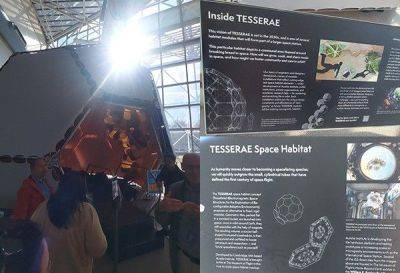House tour: Tesserae habitat for living in space
SEATTLE, USA — Space Architecture lab Cambridge Aurelia Institute early this month installed a full-size mockup of Tessellated Electromagnetic Space Structures for the Exploration of Reconfigurable, Adaptive Environments (Tesserae) in Museum of Flight, Seattle.
Tesserae, said the museum’s Senior Public Relations and Promotions Manager Ted Huetter, is a space station module that is part of the museum’s new gallery, Home Beyond Earth, which is all about space stations and living in space.
The Massachusetts Institute of Technology (MIT), in its website, describes Tesserae as a “self-assembling space architecture” for “space-faring.” The Tesserae, when combined with other units, form into “geodesic dome habitats” that can be converted into “microgravity concert halls” and even “space cathedrals.”
For now, Tesserae is being tested at the International Space Station as a self-contained habitat for a crew of four, for example, two researchers and two astronauts, with enclosed exercise and hygiene areas, lab space, an open gallery area for meals and downtime, and a storage area containing sustenance enough for a six-month-long expedition.
“Rather than transporting fixed, rigid habitation modules and risking astronaut Extravehicular Activities (EVAs) during construction, we can lower payload weight, reduce assembly complexity, and revolutionize space-structure modularity by relying on reconfigurable, self-assembly,” explains MIT, which is undertaking a multi-year research effort to study, characterize, prototype and test Tesserae.
“Tesserae,” says MIT, takes its name and concept from the standard mosaic tiles of the ancient Romans, where the tiles or “tesserae” interlock to form a bigger creation. Likewise, every Tesserae structure is formed by a set of tiles that independently self-assemble into a particular geometry. Every tile is equipped with responsive sensing and a control code for bonding, clamping and sealing for pressurization together with other tiles.
The little gray tiles have electromagnetic poles that push and guide them to bond, and they have been tested in space, said Huetter. Once the tiles are in orbit around the earth, they self-assemble through







